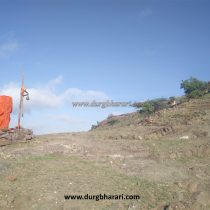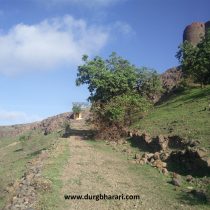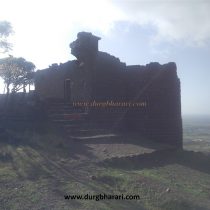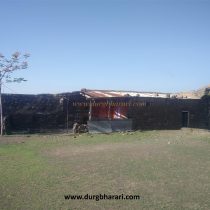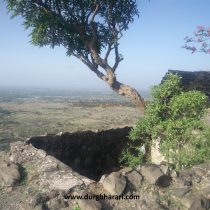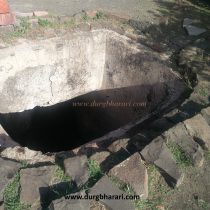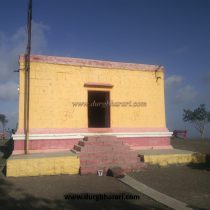DHAVALGAD
TYPE : HILL FORT
DISTRICT : PUNE
HEIGHT : 2840 FEET
GRADE : EASY
Each fort has its own identity in history but some forts have not been recorded in history. Many such forts have been forgotten today. Of the many such forts, Dhavalgad is more famous due to controversy rather than its discovery. The fort stands on a small hill behind Amble village near Saswad. This fort is only known to locals and scholars as Dhavalgad-Dhavaleshwar. This place is credited with the inclusion of Omkar Onk and Dr. Sachin Joshi in the list of fort lovers, but this fort has also been mentioned in many places before. The first mention of Dhawalgad is in the book 'Kille Purandar' published in 1940 by senior historian K.V. Purandare. Shivshahir Babasaheb Purandare's book “Raja Shivchhatrapati” also mentions Dhavalgad. G.N. Dandekar has mentioned Dhawalgad as a fort in his book 'Kille'.
...
This fort is also mentioned in the book of “Saad Sahyadrichi bhatkanti killyanchi” by PK Ghanekar. In recent times, Shivajirao Ekke's book "Purandar Parisar" and "Purandarche Dhurandhar" have mentioned the name of Dhawalgad. Information about this long-neglected fort has become readily available due to controversy. The road from Pune to Dhawalgad is Saswad-Vanpuri-Waghapur-Amble. This distance is about 55 km. Before entering Amble village, a dirt road has gone from the right to Amble railway station. This road has a fork leading to Dhawalgad. From here we reach the fort in 15 minutes. Another way to reach the fort is Pune-Lonikalbhor-Urulikanchan-Dalimb and this distance is 40 km. Even though the distance is less by road, it is difficult to reach Dhalgad from the foothill village of Dalimb and it takes about an hour and a half. Therefore, the first way to reach the fort from Pune is more convenient and you can see the Nagarkot of Ambale village and the palace of Peshwa's cavalries Chief Darekar. At the end of the dirt road, where your car stops, there is a bore well, and on the top of this bore well, you can see a mortar for grinding limestone. This grinding wheel, however, is not here. Remains of an object can be seen near this. From here, the only surviving bastion and ramparts of Dhavalgad, as well as the plateau under it can be seen. The upper part of the bastion is made out of bricks. From here, on foot, you can see the idol of Hanuman built on a quadrangle structure. The feature of this idol is that these two idols are carved out of one stone on each side as if these idols are watching the passers-by. There are steps to reach the fort in the next part of the quadrangle structure. Keeping the ramparts to the right, these steps lead to the entrance of the fort. On the left-hand side of the road, an idol of Lord Ganesha can be seen in a dome. There is a small plateau in front of the gate that looks like a machi of the fort but no remnants can be seen on it. This narrow-shaped fort is spread east-west and has an east-facing entrance at an altitude of 2845 feet above sea level. The square-shaped head of the fort has a length of 130 x 110 feet and an area of about 12-15 gunthas. The head of the fort is very small. Adjacent to the door and the wall are two rooms. Adjacent to the bank, there is a 15-20 feet deep cistern carved in the rock, but at present this cistern is dry. The main place on the fort is the Dhavleshwar Mahadev Temple. The temple has two parts, the prayer hall, and the sanctum sanctorum. Nandi has been established in the prayer hall. The construction of the temple may have been done during the Peshwa period. There are water cisterns in front of the temple and the water from these cisterns is used by the temple as well as for drinking. The ramparts on the other side of the fort have completely collapsed and a closer look reveals the remains of the ramparts. Tulsi Vrindavan is at the back of the temple and a dome and Nandi can be seen next to it. Apart from this, on the opposite side of Amble village, on the way up from Dalimb village, there is a 10-12 feet deep dry cistern carved in a rock. Looking from the fort, you can see some trees on the way up from the Dalimb village. There is an idol of Lord Ganesha and a Shivling among these trees under a tin shed. This is where your fort round ends. If you want to see the ruins on the way to Dalimba village, it takes one hour to complete the fort round, otherwise, half an hour is enough to see the top of the fort.
© Suresh Nimbalkar


